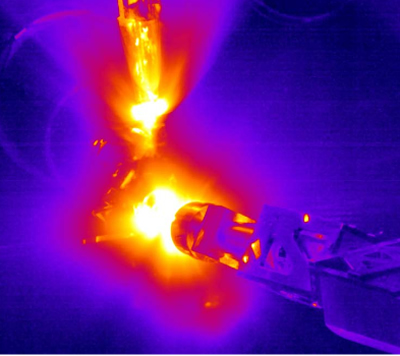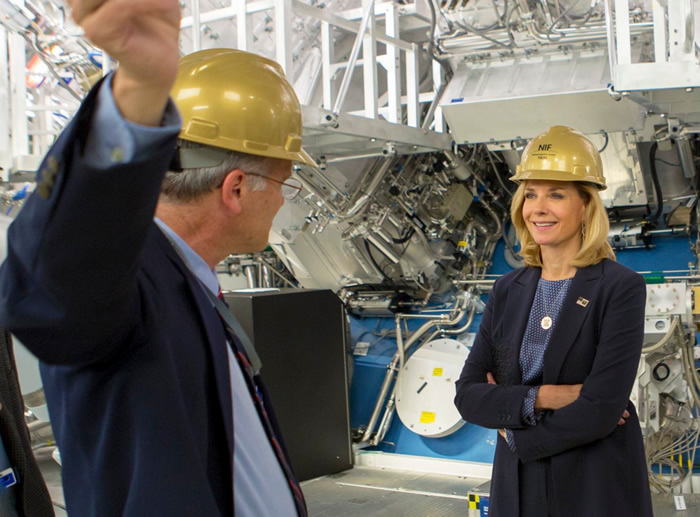Helping to Secure the Nuclear Stockpile
 Image of a NIF experiment at the moment of peak implosion. This experiment was aimed at developing a high-pressure strength measurement capability for plutonium.
Image of a NIF experiment at the moment of peak implosion. This experiment was aimed at developing a high-pressure strength measurement capability for plutonium. In the 1990s, the United States ceased underground nuclear testing, and the Department of Energy created the science-based Stockpile Stewardship Program to maintain the safety, security, and reliability of the U.S. nuclear deterrent without full-scale testing.
With decades of world-leading research on lasers and inertial confinement fusion (ICF), Lawrence Livermore National Laboratory was uniquely positioned to meet the challenge of studying the science of nuclear weapons in the absence of underground testing.
And when the nation needed a new scientific instrument to ensure continued confidence in our nuclear stockpile, LLNL provided a solution—the National Ignition Facility.
“NIF is opening up whole new frontiers in high energy density science … high-pressure-strength equations of state, hydrodynamics, dense plasma effects—many of the key scientific areas underpinning our continued confidence in the science-based stewardship of our weapons stockpile.”
—Energy Secretary Ernest Moniz, stockpile stewardship 20th anniversary event, Oct. 21, 2015
The world’s most energetic laser is designed to create the extreme conditions—temperatures of 100 million degrees and pressures 100 billion times that of the Earth’s atmosphere—that are similar to those in stars and in detonating nuclear weapons.
NIF can repeatedly simulate those conditions inside the controlled environment of the Target Chamber, giving dedicated teams of scientists and researchers the ability to reconstitute and improve upon the capabilities of underground testing on a daily basis.
The ICF and high energy density experiments, coupled with the increasingly sophisticated simulations available from some of the world’s most powerful supercomputers right here at the Laboratory, serve to increase our understanding of weapons physics, including the properties and survivability of weapons-relevant materials.
NIF’s unique capabilities, including flexible and repeatable experimental configurations, precision target fabrication and metrology, and advanced diagnostics, allowed the weapon programs of the national security laboratories to execute and deliver data in relevant regimes previously inaccessible to the Stockpile Stewardship Program. Weapon researchers are now able to measure the phase, strength, and equation of state of plutonium and other weapon-relevant materials in extreme pressures, densities, and temperatures. The data from those experiments are used to validate 3-D weapon simulation codes and inform Life Extension programs, the regularly planned refurbishments of nuclear weapon systems to ensure long-term reliability.
 NIF experiments are uniquely capable of informing and validating three-dimensional weapons-simulation computer codes that support the W80-4 Life Extension Program (LEP) effort.
NIF experiments are uniquely capable of informing and validating three-dimensional weapons-simulation computer codes that support the W80-4 Life Extension Program (LEP) effort. The studies help improve weapon physics simulations and will continue to pay dividends for certification of life-extended weapon systems and the annual assessments National Nuclear Security Administration (NNSA) laboratories conduct to evaluate if the U.S. stockpile is aging acceptably.
In addition, researchers are using NIF to provide hostile x-ray and neutron environments for vulnerability and hardness testing. NIF radiation sources help researchers evaluate how well U.S. weapons will be able to survive—and function as expected—after traversing evolving adversary missile defenses. Without the ability to survive, these weapons would be unable to hold targets at risk, rendering the deterrent ineffective.
“Deterrence is only useful if it makes potential aggressors understand that we can exact damage on them,” says NIF and Photon Science Principal Associate Director Jeff Wisoff.
Perhaps just as importantly, the high rigor and multidisciplinary nature of NIF experiments play a key role in attracting, training, testing, and retaining new generations of skilled stockpile stewards who will continue the mission to protect America into the future.
 During a May 2018 visit, NNSA Administrator Lisa Gordon-Hagerty was briefed on NIF’s role in NNSA’s science-based Stockpile Stewardship Program by NIF & Photon Science Principal Associate Director Jeff Wisoff. Credit: Jason Laurea
During a May 2018 visit, NNSA Administrator Lisa Gordon-Hagerty was briefed on NIF’s role in NNSA’s science-based Stockpile Stewardship Program by NIF & Photon Science Principal Associate Director Jeff Wisoff. Credit: Jason Laurea More information:
“NIF Experiments Support Warhead Life Extension”
“Why Ignition? NIF Experiments and Stockpile Stewardship”
“What Is Stockpile Stewardship?” (Video)
“Firing Up NIF for National Security Applications”
Next Up: The Pursuit of Ignition



